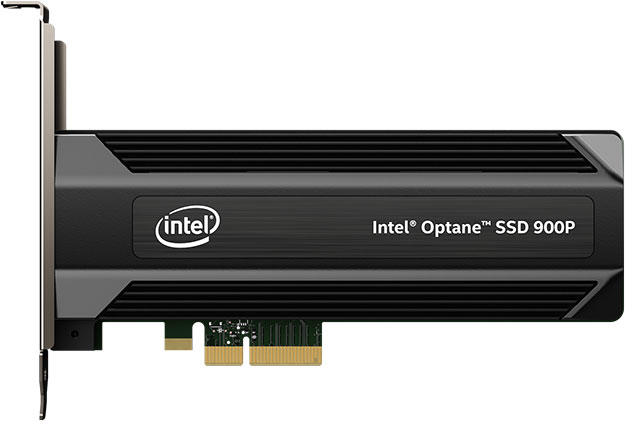Intel Optane SSD 900P Series Leverages 3D XPoint Memory For Blazing Fast Performance

We have been hearing a lot about 3D XPoint memory (now called Optane) over the past couple of years, and more recently we have seen some related products emerge, including a PCIe-based solid state drive for enterprise clients, the Intel Optane SSD DC P4800X. Intel today is following that up with the Optane SSD 900P Series, a new SSD line that also uses 3D XPoint memory, but is aimed at consumers.
This is the second 3D XPoint product that is intended for consumers, the first being Intel Optane Memory, which is essentially an ultra-fast cache buffer to speed up systems that are saddled with a crusty old hard drive (you can use Optane Memory with a SSD as well, but the results are tempered compared to pairing it with a mechanical and comparatively slow HDD). While neat, consumers have been waiting for an Optane-based SSD solution, and now it is here.

"The Intel Optane SSD 900P Series brings the workstation-class performance and industry-leading endurance of Intel Optane technology to a client SSD for the first time, and we know end users will find exciting ways to take advantage of the drive to do great things," said Bill Leszinske, Intel vice president, Non-Volatile Memory Solutions Group, and director of strategic planning, marketing and business development.
Intel is offering its Optane SSD 900P family in two different form factors— a 280GB 2.5-inch U.2 drive and a half-height half-length add-in card (HHHL AIC) that is available in 280GBa nd 480GB capacities. Both form factors tap into the PCIe bus to deliver speedy file transfers. Intel rates the sustained sequential read performance at 2,500MB/s (2.5GB/s) and sustained sequential write performance at 2,000MB/s (2GB/s), along with random 4K reads and writes of up to 550,000 IOPS and 500,000 IOPS, respectively.
What Intel is offering up is a drive series that in some cases is much faster than a typical PCIe-based SSD using NAND flash memory. That has long been the promise of the 3DXPoint memory—it is supposed to significantly outperform NAND flash memory, and as implemented in the Optane SSD 900P Series, a variety of workloads should see a performance boost. Shown above is a workstation benchmark (SPECwpc) that highlights the performance gap.
Intel's pitch to professionals is that its Optane SSD 900P Series delivers faster project loading and simulation in engineering workloads, but that is not the only demographic Intel is taking aim at. It also hopes to attract media content creators, including game developers, and consumers who play games.
To drive the point home that gamers may benefit from an Optane SSD 900P Series drive, Intel has partnered up with Cloud Imperium Games to bundle Star Citizen with its new drives, along with an exclusive in-game Sabre Raven ship that will not be available anywhere else.
"The Intel Optane SSD 900P Series is amazingly fast, easily the fastest drive I have ever used," said Chris Roberts, chairman and CEO at Cloud Imperium Games and Roberts Space Industries. "Our Star Engine developers have been working on technology to improve loading times using new techniques developed for Star Citizen and optimized for the Intel Optane SSD 900P Series, which is the fastest SSD we’ve tested."
Intel's Optane SSD 900P drives perform well under load with high queue depths. Combined with the way Star Citizen streams massive amounts of data from storage, using one of these drives should offer a real performance benefit over a NAND-flash memory SSD, even ones that utilize the PCIe bus.
For more on Star Citizen, CitizenCon is being livestreamed now. As for the Optane SSD 900P Series drives, they are available today priced at $389 for the 280GB models and the $599 for the 480GB add-in card.





